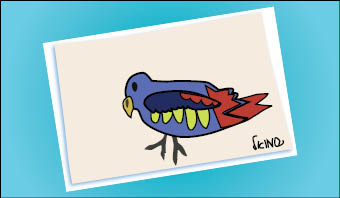
When I think of crafts and creativity, I think of Bezalel. God chose him, as mentioned in Exodus 31, to fashion and oversee the work of the building of the Tabernacle. God did not choose to build the Tabernacle as a wood cabin or as a tent made of simple cloth, and put in it regular lamps as in every standard house. He also did not choose to just put a wooden closet in the Holy of Holies, but rather chose to build a beautiful tabernacle, in which each element in it is creative and special, and even more importantly – reminiscent of Him in a certain way. The lamp stand had cast gold moldings in the shape of a button and a flower; the covering of the tent was made of four layers of fabric, in four specific colors that describe different characteristics of God; the curtain that separated the Holy Place from the Holy of Holies was also magnificent, made of a red woven fabric with a spectacular pattern on it. All the artistic elements spoke of God, His attributes and His greatness.
What does this have to do with us…in our work with children?
Crafts in Children’s Ministry
We sang songs, prayed, learned a story from the Bible, and now it’s time to do an activity that will strengthen what we learned from the lesson. What should we do? A game, craft, conversation, skit? Let’s think about this a bit…when you think deeply about what you want to achieve in those ten minutes of activity, what thoughts go through your head?
What is our ultimate goal when we teach the children? Their salvation and growth in their relationship with God. That’s a very great aim, and to achieve it one has to take several steps. Some of those steps are the Sabbath lessons and all the activities that are done in them. We have very little time with the children, and for some of them this is the only time in which they learn the Word of God, so it is very important to have everything in the lesson focused and take advantage of every moment.
Why do we have activities after we’ve finished teaching the lesson? Because that’s what the instructions say? Because that’s the way it’s done? Because it fills time? Because the kids enjoy it? Or so that the message we tried to convey in the lesson would be passed on in another manner, in a way that would leave its mark and cause the children to remember what they learned over time? It is better that the children enjoy the activity and it does fill time – these are positive things, but they are not the purpose of the activity.
The activity we’re going to talk about today is crafts. According to Mylog, a craft is “an abstract term, describing the reference to something as the product of complex processes of added subjective value. In everyday language, it is customary to refer to a work as an artistic product, for example: a book, a painting or a poem.” When we talk about crafts with children in a Bible class, we’re talking about an artistic work that the children create, which is a product of an intricate process (what the children learned during the lesson) and its additional subjective value is the application of what was learned in the lesson as an artistic product. Simply stated, it’s an object that the children create that reminds them of what they’ve learned in the lesson or allows them to apply the lesson’s aim. Example: The children learned that the boy who shared his food with Yeshua and the 5,000 people who came to learn from Him was Yeshua’s helper. During the craft time the children decorated a jar to their preference, and filled it with candy. They gave out the candy, and so they were acting as the boy who donated his lunch. They implemented the purpose of the lesson.
What crafts offer to children:
- Crafts help apply and internalize what is being taught in class. They remain for a long time and thus create a reminder of what is being learned, the morals and the verse that was learned in that lesson.
- The craft allows the children to take home something that serves as an object for conversation with the family, as well as with anyone who sees it. This can help start a discussion about faith or other things.
- It helps strengthen fine motor skills (the small muscles in the hands).
- For small children, crafts develop the ability to differentiate between different textures.
- Crafts develop creativity.
- Crafts stimulate the thinking process.
- Crafts help use the children’s energy in a different way.
- Crafts contribute to the development of the child’s personality and turns him into a more “rounded”, deeper individual.
- Crafts help in the development of life skills such as sewing, adhesion (which glue is used with which materials), which colors match each other, threading, visualizing space and its dimensions, etc.
- Crafts help children express what they have in their hearts, which they don’t know or have difficulty expressing in words.
There are different types of crafts: cutting and gluing, the use of various materials to build objects (e.g., the use of a roll of toilet paper to create a model of Jericho that was conquered by the Israelites; the use of wood, hammer and nails to build the Ark of the Covenant; using wool to make pom-poms, etc.), two-dimensional and three-dimensional crafts, the creating of practical items (such as a pencil stand, a stone for holding a door open, a container to put candy, a shirt, etc.) I spoke to an art teacher at a middle school in Jerusalem. She told me that she teaches basic life-skills to the students in her class – how to sew basic stitches, how to attach a button, how to look at an object (such as a cube or a tree) and draw it, even in the simplest way, so that they can build a similar one from modeling clay, etc.
It doesn’t matter what kind of craft you choose, but it is important that the memory verse will be on every one, so that it will always be before their eyes. It will be a catalyst for behavior or conversation, and will also be a witness to those around.
At any age, the level of craftsmanship will be different. Of course, for older children the craft will be more complex, and the results will be better (obviously, the end product will be “better” for a child who has had more experience with crafts). For older children, it is not recommended to regularly incorporate crafts in the lessons; they are old enough to learn God’s Word systematically and deeply, and their activity in the lesson will be more academic in nature (using the reading of Scripture and understanding the text deeply, and the insights that can be learned from the Scriptures through prayer and discussion).
Not everyone likes to do crafts, so it’s important to diversify. There are children who, as soon as the craft materials are taken out, they suddenly are no longer interested, are unwilling to cooperate, wanting to go to their parents… It’s at that very moment that you have to help the child see that there are things in the craft that he will like. Sit with him, do the craft together with him (give him a good experience of success). Even if it’s just for a short while, require that the child work on the craft. With time he’ll learn to find those areas of creating that he does like or is willing to do, and he will leave the classroom, like all the others, with a product that he can take home and proudly show to his parents, and that will be a trigger to talk about what he learned in class.
Even if you’re not creative, provide the children with the materials necessary to do the craft, and you’ll see that they’ll be small artists and can create lovely things. You can draw ideas from the teacher manuals you use, from other teachers, or from the internet.
Recommended basic materials that you should have on hand:
- Scissors
- White paper of different sizes
- Bristol of different colors/white/black
- Paper fasteners
- Pencils/Pens
- Crayons (markers, color pencils, water paints)
- Glue stick
- Regular tape
- Masking tape
- Cotton balls
- Stickers (circles of different colors, beautiful stickers, animal stickers, etc.)
- One-hole puncher
- Stapler
- White glue
- Laminating machine
- Exacto-knife
If there is a good storage place, save these for when needed:
- Toilet paper rolls
- Hand paper rolls
- Small jars (plastic is better than glass)
- Straws
- Two-sided tape
- Insulating tape
- Hot glue
- Gouache paint
- Magnetic tape
- Pipe cleaners
- Carton

